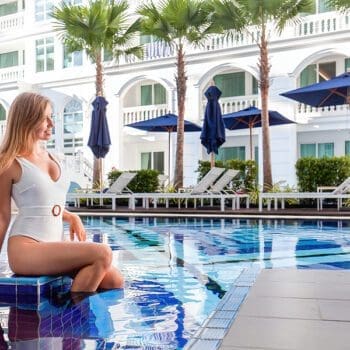 We’re seeing a trend in post-pandemic luxury – the mantle of attaining then surpassing a thousand dollars per night per room. This is what we have dubbed the ‘Mille Club’ after the Italian for said four-digit number. If your average daily rate has pushed into the four-figure range or thereabouts, congratulations and welcome. But know that this is something that must be earned because of the psychology that comes with paying above this threshold and because luxury guests have plenty of options nowadays.
We’re seeing a trend in post-pandemic luxury – the mantle of attaining then surpassing a thousand dollars per night per room. This is what we have dubbed the ‘Mille Club’ after the Italian for said four-digit number. If your average daily rate has pushed into the four-figure range or thereabouts, congratulations and welcome. But know that this is something that must be earned because of the psychology that comes with paying above this threshold and because luxury guests have plenty of options nowadays.
As the second entry in this column, the focus is still on what every hotelier can learn from brands that are maintaining $1,000+ ADRs. While such revenues can subsidize elevated staffing and extravagant amenities, we emphasize that a large part of Mille Club membership comes down to the intangibles, the nuances and a scrupulous attention to detail – something that any hotel can set out to achieve no matter the star rating or budget. And per the title of this second outing, we can bring this argument into focus by highlighting examples across each major part of the guest journey.
Start with the employees
That statement might seem a bit convoluted. So, let’s back up a minute. Guest satisfaction is derived from two key elements: product and service. Putting your physical product aside for a moment, guest service is the interaction between your team members and your guests. This means that your employees need to be trained or retrained for their enhanced roles.
Do not expect your team to immediately undertake the changes that may be necessary. Some of them are quite subtle. Encouragingly, most are fully trainable, although the passion for hospitality has to be there. Your role is to facilitate this training program and provide your employees with both the necessary tools and time to accomplish their expanded duties.
Guest prearrival
It’s all about the data. For all guests, both new and repeat, your CRM is invaluable. For new guests, create a storehouse of information. This should include the basics of name, address, reservation source, date, single/double/family occupancy, length of stay and room type. Should they happen to be a repeat customer, append the latest data to their file, update and note any commonalities. Note arrival and departure times as well as if transfers were taken. The nuances of the data will inform future service requests as well as what you can do to anticipate needs or create points of personalization; you need only have the time to look.
Above all, don’t wait for the guest to cross your threshold. Communicate restaurant opening hours and suggest dinner reservations. If a leisure trip or a resort, consider poolside cabanas, spa sessions or golf tee time scheduling to ensure availability and avoid disappointment. Every guest would appreciate a personal assistant of sorts to help set up personalized experiences. Newcomers to your city should be encouraged to rely on you to manage extras such as local or specialized tours. While many of these services provide added revenue opportunities, they also create and establish a relationship while enhancing your property’s value.
An often-forgotten part of prearrival is room inspection by a housekeeping supervisor or manager. Simply put, rooms must be perfect. There is no provision for errors. Welcome letters and treats should be planned and in place.
As a supplemental tip, use LinkedIn to learn more about your guest and their interests. Tap your CRM to flag past guest data. Create a welcome gift that shows some unique character with local flavor. Make sure your accompanying handwritten note is genuine. It does not have to be from the GM. At the Boston Harbor Hotel, our welcome gift came from the Executive Chef, knowing that we were a past guest and appreciated his F&B selections.
The two parts of arrival
The welcome experience should be memorable and worthwhile. Armed with a dossier, your reception team can warmly greet the guest personally. The first part takes place in your lobby. Learn to treat every guest as a VIP. The days of staff hiding behind a Plexiglas barrier is over. Staff needs to warmly greet each guest and step out from behind any barrier such as a front desk. Obtain all necessary credit information. While challenging from a staffing standpoint, each guest in a Mille Club hotel is ushered to their room. And remember, it is all about personalization; know the name of the guest and address them appropriately.
Part two is in the guest’s suite. Staff training is important here. Once the room is entered, time should be taken to explain the room’s function, in particular any technologies such as WiFi access, television access, casting, IoT room controls and other electronic functions. Breakfast information needs repeating. Minibar function should also be identified, reinforcing those items that are provided to the guest as a convenience at no charge. Remind guests of access to concierge services (both live and on-app). If you do not have an app, at a minimum, give the guest a business card with appropriate contact information. Remind your staff to listen and keep their welcome short as they are on the guest’s clock. And once they return to the front desk, immediately record any request or preferences.
For training purposes, we suggest that you roleplay this critical process with every member of your reception staff. After greeting us, the Londra Palace Venezia receptionist escorted us to our room, explaining all aspects of the property along the way and as they did not have the electronics in place, gave us a card with a number to text or call 24/7. This was not a substitute for the concierge, but rather a way to reinforce that there was always someone ready to help.
During the stay
Think extras. How can you make the stay more memorable? Every time the guest uses their in-room telephone, they should be greeted by name. There may not be many, but all requests should be handled expeditiously. For housekeeping, the memorability comes in your turndown service. Your turndown team should be synchronized to complete their tasks while the guest is having dinner, coordinated to avoid any disruption in pre-dinner activities. Apart from housekeeping duties, ensure that they have more than just a tractional chocolate on the pillow. Use your imagination. A personal note (initialed by the housekeeper) is an appropriate touch. Locally made treats trump mass produced items. Stays of more than three nights deserve refreshment of fruit baskets and welcome amenities.
For example, the Halekulani Hotel in Honolulu has a separate turndown amenity for each day of the week, as they recognized that guests would get bored of the same trinket every night during an extended stay. At both The Savoy Hotel (in London) and the Baur au Lac (in Zurich) the minbar was free. Remember, your guests will arrive back at their rooms and may just want a soft drink or a light snack as they get ready for dinner. Charging a few bucks here is an insult.
Then the departure
If you have planned appropriately, departure is your opportunity to leave a lasting impression. Many guests check out electronically. For those who come to the front desk, remember LIFO (Last In, First Out). We have experienced many poor departures where the team member’s focus is solely transactional versus genuine communication with me about my stay and experiences. This critical part of the guest journey is rarely trained and should be a priority as guests will offer profound insights to guide the property and their own return visits.
As a guest departs, think of how you can make lasting memories. Lake Austin Spa Resort provided logoed t-shirts while the Montage Laguna Beach not only provided printout maps of the best route to the airport, but also bottled water, ballcaps and a brown bag of penny-candy munchies for the drive.
Have you adequately discussed, planned and budgeted for your guests’ departures to leave a lasting impression? You want to establish a warm and continuous relationship with your guests throughout their entire stay. It is labor intensive, but these are the subtleties that you must consider as you aim to grow your ADR in the stratosphere.
This article may not be reproduced without the expressed permission of the author.

































